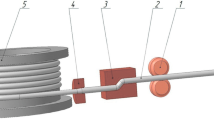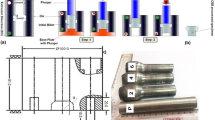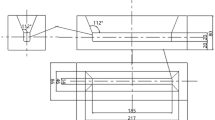The effect of combined technology of ECAE-drawing on features of ultrafine-grained (UFG) structure formation in aluminum alloy А0 is considered. Deformation by the proposed and existing schemes is conducted at room temperature with the number of passes equal to four. It is shown that ECAE-drawing leads to more significant refinement of the structure of pure aluminum compared with traditional drawing. The grains obtained are equiaxed in shape, and their size lies in the range from 0.7 to 0.8 μm. It is also established that aluminum wire strength increases after four passes by almost a factor of three. Ultimate breaking strength and yield strength increase from 145 to 400 MPa (the absolute increase is 255 MPa) and from 100 to 224 MPa (the absolute increase is 114 MPa) respectively, relative elongation is reduced by 7%, and reduction of area is reduced by 5%. It is found that after deformation by the ECAE-drawing method wire has an increased reserve of ductility compared with the traditional drawing process that makes it possible to accomplish subsequent treatment without intermediate annealing.


Similar content being viewed by others
References
R. Valiev, M. Murashkin, E. Bobruk, and G. Raab, “Grain refinement and mechanical behavior of the Al Alloy, subjected to the new SPD technique,” Materials Transactions, 50, No. 1, 87–91 (2009).
B. A. Romantsev, T. B. Huy, M. M. Skripalenko, et al., “Investigation of screw rolling process in 4-high stand by simulation,” Metallurgist, 62, No. 7–8, 618–626 (2018).
A. Naizabekov, S. Lezhnev, E. Panin, et al., “Effect of combined rolling–ECAP on ultrafine-grained structure and properties in 6063 Al Alloy,” J. Mater. Eng. Performance, 28, No. 1, 200–210 (2019).
P. M. Vinnik, K. M. Ivanov, G. A. Danilin, et al., “Studying the deformation during variable-channel direct extrusion,” Metallurgist, 61, No. 3–4, 223–229 (2017).
S. Wang, W. Liang, Yu. Wang, et al., “A modified die for equal channel angular pressing,” J. Mater. Proc. Technology, 209, No. 7, 3182–3186 (2009).
P. Frint, M. F.-X. Wagner, S. Weber, et al., “An experimental study on optimum lubrication for large-scale severe plastic deformation of aluminum-based alloys,” J. Mater. Proc. Technology, 239, No. 1, 222–226 (2017).
A. A. Bogatov and E. I. Panov, “Effect of stress-strain state during helical rolling on metal and alloy structure and ductility,” Metallurgist, 57, No. 5–6, 434–441 (2013).
Lee Sang-Kon, Lee Seon-Bong, and Kim Byung-Min, “Process design of multi-stage wet wire drawing for improving the drawing speed for 0,72 wt.% C steel wire,” J. Mater. Proc. Technology, 210, No. 5, 776–783 (2010).
Y. M. Wang, M. W. Chen, H. W. Sheng, and E. Ma, “Nanocrystalline grain structures developed in commercial purity Cu by low-temperature cold rolling,” J. Mater. Research, 17, No. 12, 3004–3007 (2002).
V. G. Molyarov, A. M. Avdeenko, A. V. Kalashnikova, et al., “Effect of deformation heat treatment on the structure of twophase steel in a bimetal composite and its mechanical properties,” Metallurgist, 61, No. 1–2, 92–98 (2017).
I. Yu. Khmelevskaya, R. D. Karelin, S. D. Prokoshkin, et Al., “Effect of quasi-continuous equal channel angular extrusion on structure and functional properties of Ni-Ti alloys with shape memory,” Fiz. Metall. Metalloved., 118, No. 3, 293–300 (2017).
D. Orlov, G. Raab, T. T. Lamark, et al., “Improvement of mechanical properties of magnesium alloy ZK60 by integrated extrusion and equal channel angular pressing,” Acta Materialia, 59, No. 1, 375–385 (2011).
V. Bratov and E. N. Borodin, “Comparison of dislocation density based approaches for prediction of defect structure evolution in aluminium and copper processed by ECAP,” Mater. Sci. and Eng.: A., 631, 10–17 (2015).
S. C. Yoon, Z. Horita, and H. S. Kim, “Finite element analysis of plastic deformation behavior during high pressure torsion processing,” J. Mater. Proc. Technology,201, No. 1–3, 32–36 (2008).
G. Raab, R. Valiev, T. Lowe, and Y. Zhu, “Continuous processing of ultrafine grained Al by ECAP-Conform,” Mater. Sci. and Eng.: A, 382, No. 1–2, 30–34 (2004).
S. N. Lezhnev, I. E. Volokitina, and A. V. Volokitin, “Evolution of microstructure and mechanical properties of steel during pressing–drawing,” Physics of Metals and Metallography, 118, No. 11, 1167–1170 (2017).
I. E. Volokitina and A. V. Volokitin, “Evolution of the microstructure and mechanical properties of copper during the pressing–drawing process,” Physics of Metals and Metallography, 119, No. 9, 917–921 (2018).
S. Lezhnev, A. Naizabekov, A. Volokitin, et al., “Development and research of combined process of “equal channel angular pressing – drawing,” J. Chem. Technology and Metallurgy, 52, No. 2, 172–179 (2017).
Author information
Authors and Affiliations
Corresponding author
Additional information
Translated from Metallurg, Vol. 63, No. 9, pp. 85–89, September, 2019.
Rights and permissions
About this article
Cite this article
Volokitina, I.E., Volokitin, A.V., Naizabekov, A.B. et al. Change in Structure and Mechanical Properties of Grade А0 Aluminum During Implementation of a Combined Method of ECAE–Drawing Deformation. Metallurgist 63, 978–983 (2020). https://doi.org/10.1007/s11015-020-00915-y
Received:
Published:
Issue Date:
DOI: https://doi.org/10.1007/s11015-020-00915-y




